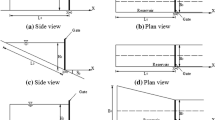Abstract
Dam break can cause a significant disaster in the downstream, especially, in a valley with cascade reservoirs, which would aggravate the disaster extent. The experimental studies of the dam-break flow of cascade reservoirs are few and far between at the present. Most of related studies concern the failure of a single dam.. This article presents an experimental study of the characteristics of an instantly filled dam-break flow of cascade reservoirs in a rectangular glass flume with a steep bottom slope. A new method was used to simulate the sudden collapse of the dam. A series of sensors for automatic water-levels were deployed to record the rapid water depth fluctuation. The experimental results show that, the ratio of the initial water depth of the downstream reservoir to that of the upstream reservoir would greatly affect the flood peak water depth in the downstream reservoir area and in the stream channel behind the downstream dam, while the influence of the dam spacing is insignificant. In addition, the comparison between the single reservoir and the cascade reservoirs shows some difference in the dam-break flow pattern and the stage hydrograph at the corresponding gauging points.
Similar content being viewed by others
References
XU Wei-lin, YANG Yong-quan and DENG jun. Hydraulic models[M]. Beijing: Science Press, 2010(in Chinese).
COCHARD S., ANCEY C. Tracking the free surface of time-dependent flows: image processing for the dambreak problem[J]. Exp. Fluids, 2008, 44(1): 59–71.
EAKET J., HICKS F. E. and ASCE M. et al. Use of stereoscopy for dam break flow measurement[J]. Journal of Hydraulic Engineering, 2005, 131(1): 24–29.
FRAZAO S. S., ZECH Y. Dam break in channels with 90° bend[J]. Journal of Hydraulic Engineering, 2002, 128(11): 956–968.
ZHOU J. G., CAUSON D. M. and MINGHAM C. G. et al. Numerical prediction of dam-break flows in general geometries with complex bed topography[J]. Journal of Hydraulic Engineering, 2004, 130(4): 332–340.
YAN Jun, CAO Zhi-xian. Experimental study of landslide dam-break flood over erodible bed in open channels[J]. Journal of Hydrodynamics, 2009, 21(1): 124–130.
NIU Zhi-pan, XU Wei-lin and ZHANG Jian-min et al. Experimental investigation of scour dam-break of landslide dam[J]. Journal of Sichuan University (Engineering Science Edition), 2009, 41(3): 90–95(in Chinese).
SUN Lu-zhong, YAN Jian-guo and ZHAO Jian-jun. Study on closure of dam-breach with sinking caissons[J]. Journal of Yangtze River Scientific Research Institute, 2003, 20(6): 9–11(in Chinese).
ZHANG Jian-yun, LI Yun and XUAN Guo-xiang et al. Overtopping breaching of cohesive homogeneous earth dam with different cohesive strength[J]. Science in China, Series E: Technological Sciences, 2009, 52(10): 3024–3029.
LI Yun, WANG Xiao-gang and XUAN Guo-xiang et al. Similarity criteria of homogeneous embankment failure due to overtopping flow[J]. Chinese Journal of Hydrodynamics, 2010, 25(2): 270–276(in Chinese).
LI Yun, LI Jun. Review of experimental study on dambreak[J]. Advances in Water Science, 2009, 20(2): 304–310(in Chinese).
HANSON G., COOK K. and TEMPLE D. Research results of large-scale embankment overtopping breach tests[C]. Proceedings of the Association of State Dam Safety Officials Annual Conference. Tampa, USA, 2002, 809–820.
STEPHEN E. C., DARRYL P. A. and GRANT M. W. Overtopping breaching of non-cohesive homogeneous embankments[J]. Journal of Hydraulic Engineering, 2002, 128(9): 829–838.
DUPONT E., DEWALS B. J. and ARCHAMBEAU D. et al. Experimental and numerical study of the breaching of an embankment dam[C]. Proceeding of the 32nd IAHR Biennial Congress. Venice, Italy, 2007, 1: 339–348.
GUO Yan, LIU Ru-xun and DUAN Ya-li et al. A characteristic-based finite volume scheme for shallow water equations[J]. Journal of Hydrodynamics, 2009, 21(4): 531–540.
YU Ming-hui, DENG Yin-ling and QIN Lian-chao et al. Numerical simulation of levee breach flows under complex boundary conditions[J]. Journal of Hydrodynamics, 2009, 21(5): 633–639.
WANG Xin, CAO Zhi-xian and YUE Zhi-yuan. Numerical modeling of shallow flows over irregular topography[J]. Journal of Hydrodynamics, Ser. A, 2009, 24(1): 56–62(in Chinese).
PAN Cun-hong, YU Pu-bing and LU Hai-yan. Numerical simulation of wetting and drying for shallow flows by Riemann solution on dry bed[J]. Journal of Hydrodynamics, Ser. A, 2009, 24(3): 305–312(in Chinese).
JIANG Yan-qun, DUAN Ya-li and LIU Ru-xun et al. An unstructured-mesh MATLAB generator and numerical simulation of shallow water problems[J]. Chinese Journal of Hydrodynamics, 2009, 24(4): 398–405(in Chinese).
SONG Li-xiang, ZHOU Jian-zhong and ZOU Qiang et al. A well-balanced Riemann solver for one-dimensional shallow water equations[J]. Chinese Journal of Hydrodynamics, 2010, 25(2): 231–238(in Chinese).
ZHANG Xue-ying, PAN Zhong-jian and MA Xiao-fei. Numerical simulation for breaking waves impacting on a building in complex boundary with the SPH method[J]. Chinese Journal of Hydrodynamics, 2010, 25(3): 332–336(in Chinese).
ZHOU Hao-lan, CHEN Yang-bo and REN Qi-wei. The shallow-water simulation for irregular terrain[J]. Chinese Journal of Hydrodynamics, 2010, 25(5): 594–600(in Chinese).
LI Tai-ru, ZHAO Ming-deng and PENG Xiao-chun. Finite proximate method for dam-break flood waves with real topography[J]. Chinese Journal of Hydrodynamics, 2010, 25(6): 763–769(in Chinese).
BUKREEV V. I., GUSEV A. V. Initial stage of the generation of dam-break waves[J]. Doklady Physics, 2005, 50(4): 200–203.
Author information
Authors and Affiliations
Corresponding author
Additional information
Project supported by the National Basic Research Program of China (973 Program, Grant No. 2007CB714105), the National Natural Science Foundation of China (Grant No. 50909067).
Biography: XUE Yang (1983-), Male, Ph. D. Candidate
Rights and permissions
About this article
Cite this article
Xue, Y., Xu, Wl., Luo, Sj. et al. Experimental Study of Dam-Break Flow in Cascade Reservoirs With Steep Bottom Slope. J Hydrodyn 23, 491–497 (2011). https://doi.org/10.1016/S1001-6058(10)60140-0
Published:
Issue Date:
DOI: https://doi.org/10.1016/S1001-6058(10)60140-0




